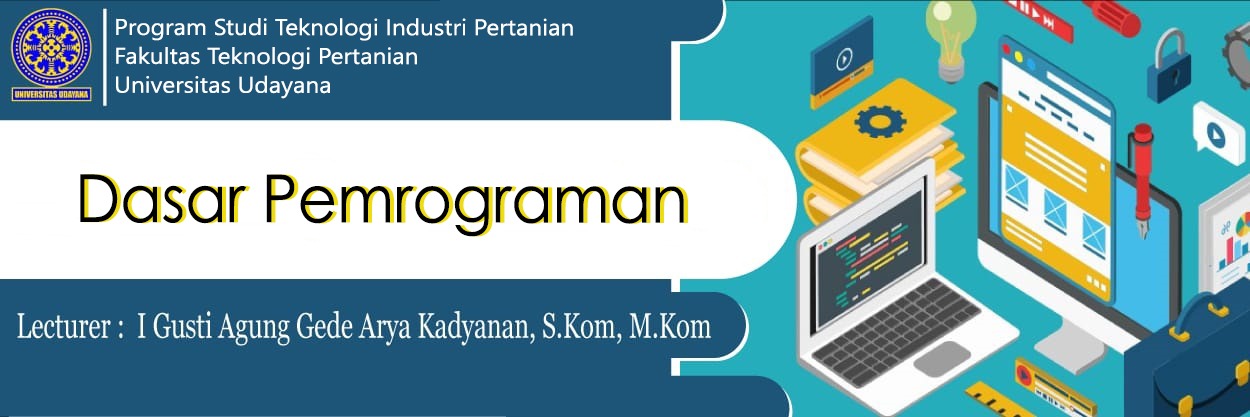Cis 267 Visual Basic Programming Upload Assignment: Week 3 Lab Assignment 3
-
.
-
Dear korma dan seluruh mahasiswa/i peserta perkuliahan Dasar Pemrograman, dapat saya informasikan bahwa perkuliahan minggu ini (Selasa, 23 Pebruari 2021) saya tiadakan dikarenakan saya sedang mengikuti pelatihan Microcredential Bogus Intelligent yang diselenggarakan oleh Kemendikbud dari tanggal 22-26 Pebruari 2021. Demikian untuk dimaklumi. Perkuliahan berjalan seperti biasa pada minggu berikutnya. Terima kasih.
-

LECTURER

Proper name : I Gusti Agung Gede Arya Kadyanan, Southward.Kom.,M.Kom 
E-mail : gungde@unud.ac.id 
Phone : 082178787849
COURSE DESCRIPTION see details on Syllabus/RPS
This form discusses several topics such every bit:Affiliate 1 - Introduction to computers, Cyberspace and Visual Basic .NET, Chapter ii - Introduction to the logic and algorithm, and Visual Studio .Internet IDE, Chapter 3 – Algorithm Representation and Introduction to Visual Basic Programming, Affiliate 4: Branching/Control Structures, Chapter 5: Looping and Procedures, Chapter 6 – Sub Procedure and Graphical User Interface Concepts, Chapter vii – Introduction to Data Structures, Chapter 8 – Information Structures Technique and RDBMS (Relational Database Management Arrangement), Chapter nine – SQL, Chapter 10 – ADO.NET, Chapter eleven - ASP .Net, Chapter 12 - Web Forms and Spider web Controls, Chapter 13 - Web service, Chapter 14 - Spider web Services (cont).
PREREQUISITES see details on Syllabus/RPS
-
Course OBJECTIVE meet details on Syllabus/RPS
To learn and implement basic concepts of logic and algorithm as a basic in programming languages.
CREDITS SEMESTER see details on Syllabus/RPS
This course is offered in odds semester with a load of 3 credits
In every week/topics volition consists of three master sections which are combined into aBlended Course. In that location are three sections such as Face up to face department, Structured Consignment, and Contained Assignment.
Every section is prepared every bit follow:
-
Face to face (F2F) department with time allocates iii ten 50 minutes in every week.
-
Structured Consignment section with time allocates 3 x 60 minutes in every calendar week
-
Contained Assignment section with time allocates 3 x 60 minutes in every week.
Plan LEARNING OUTCOMES (PLO) /CPLsee details on Syllabus/RPS
Class LEARNING OUTCOMES (CLO) /CPMKsee details on Syllabus/RPSCourse MATERIAL see details on Syllabus/RPS
- Affiliate 1- Introduction to Computers, Net and Visual Basic .Internet,
- Affiliate 2 - Introduction to the logic and algorithm, and Visual Studio .NET IDE;
- Chapter three - Algorithm Representation and Introduction to Visual Bones Programming;
- Affiliate 4 - Branching/Control Structures;
- Affiliate 5 - Looping and Procedures;
- Chapter 6 - Sub Process and Graphical User Interface Concepts;
- Chapter 7 - Introduction to Data Structures;
- Affiliate eight - Information Structures Technique and RDBMS (Relational Database Management Organization);
- Chapter 9 - SQL;
- Chapter 10 - ADO.Cyberspace;
- Chapter 11 - ASP .Net;
- Chapter 12 - Web Forms and Web Controls;
- Chapter 13 - Web service;
- Chapter xiv - Web Services (cont);
GRADING SCHEME see details on Syllabus/RPS
Grading Component : Proportion Quis : thirty% Midterm Examination : 20% Last Exam : xx% Assignment : 30%
ASSESSMENT meet details on Syllabus/RPS
Range Value Grade Value Country eighty-100 A 4.0 Splendid 70-<lxxx B+ 3.5 Very Good 65-<70 B 3.0 Practiced lx-<65 C+ ii.5 Adept Enough 55-<60 C 2.0 Plenty 50-<55 D+ 1.five Less than plenty 45-<50 D 1.0 less <45 E 0.0 Fail
REFERENCE meet details on Syllabus/RPS
Course Cloth Source Title Chief references supporting the course: : Programming with Visual Studio.NET . Ted Coombs. Boosted references supporting the course: :

-
-
-
Class Programme (Week i)
-
Students Learning and Skill upshot / KAM
- Students are able to explicate the course plan and its relationship to another course,Introduction, What is a Computer?, Computer Organisation, Evolution of Operating Systems, Personal Calculating, Distributed Computing and Customer/Server Calculating,Car Languages, Assembly Languages and Loftier-Level Languages,Visual Basic .NET,C, C++, Java and C#, Other High-Level Languages,Structured Programming,Central Software Trend: Object Technology, Hardware Trends,History of the Internet and World wide web,World wide web Consortium (W3C),Extensible Markup Linguistic communication (XML)
-
-
Chapter 2 - Introduction to the logic and algorithm, and Visual Studio .NET IDE (Calendar week ii)
-
Students Learning and Skill outcome / KAM :
Students are able to explain and bear witness a relevant example the concept of Introduction,Overview of the Visual Studio .Cyberspace IDE,Carte Bar and Toolbar,Visual Studio .NET IDE Windows (Solution Explorer,Toolbox,Properties Window),Using Help,Unproblematic Program: Displaying Text and an Paradigm
-
-
Chapter 3 – Algorithm Representation and Introduction to Visual Bones Programming (Week iii)
-
Students Learning and Skill upshot/KAM:
Students are able to explain introduction and implement, Simple Program: Press a Line of Text, Another Uncomplicated Program: Calculation Integers, Memory Concepts, Arithmetic,Determination Making: Equality and Relational Operators, Using a Dialog to Brandish a Bulletin
-
-
Chapter 4: Control Structures (Calendar week 4)
-
Students Learning and Skill outcome / KAM :
- Students are able to explain Introduction andimplement, Algorithms,Pseudocode, Control Structures, If/Then Selection Structure, If/Then/Else Choice Structure, While Repetition Structure, Practise While/Loop Repetition Structure, Practise Until/Loop Repetition Structure, Assignment Operators
-
-
Midterm Examination (UTS)
-
- UTS akan dimulai pukul 12.00 Wita.
- Silahkan dikerjakan soal UTS berikut ini dengan memilih salah satu opsi yang dianggap paling benar.
- Durasi pengerjaan selama 60 menit.
- Kirimlah jawaban/submit sebelum waktu habis atau UTS tidak akan masuk ke sistem.
-
- UTS akan dimulai pukul 10.00 Wita.
- Silahkan dikerjakan soal UTS berikut ini dengan memilih salah satu opsi yang dianggap paling benar.
- Durasi pengerjaan selama 60 menit.
- Kirimlah jawaban/submit sebelum waktu habis atau UTS tidak akan tercatat ke sistem.
- Permasalahan yang terjadi diakibatkan kesalahan koneksi dan teknis individu tidak dapat melaksanakan uts susulan kembali.
-
Source: https://lmsspada.kemdikbud.go.id/course/view.php?id=3219
0 Response to "Cis 267 Visual Basic Programming Upload Assignment: Week 3 Lab Assignment 3"
Post a Comment